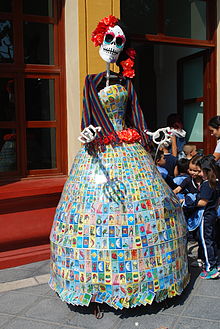Lotería: Difference between revisions
m →History: Added citation. |
|||
| Line 54: | Line 54: | ||
'''8 ''La botella''''' ("the bottle") |
'''8 ''La botella''''' ("the bottle") |
||
:''La |
:''La herramienta del borracho.'' |
||
:The tool of the drunk. |
:The tool of the drunk. |
||
Revision as of 05:16, 1 March 2017
This article has multiple issues. Please help improve it or discuss these issues on the talk page. (Learn how and when to remove these messages)
|

Lotería is a game of chance, similar to bingo, but using images on a deck of cards instead of plain numbers on ping pong balls. Every image has a name and an assigned number, but the number is usually ignored. Each player has at least one tabla, a board with a randomly created 4 x 4 grid of pictures with their corresponding name and number. Players choose what tabla they want to play with, from a variety of previously created tablas. Each one presents a different selection of images.
Lotería is the Spanish word for lottery. The deck is composed of a set of 54 different images, each one in a card. To start the game, the caller (cantor, or singer) randomly selects a card from the deck and announces it to the players by its name, sometimes using a riddle or humorous patter instead of reading the card name. The players with a matching pictogram on their board mark it off with a chip or other kind of marker (many Mexican people traditionally use small rocks, crown corks or pinto beans as markers). The first player with four chips in a horizontal, vertical or diagonal row, squared pattern,any other previously specified pattern, or fills the tabla first shouts "¡Lotería!" (Lottery!) or "¡Buenas!" (Good!) and is the winner.
History



The origin of lottery can be traced far back in history. The game originated in Italy in the 15th century and was brought to New Spain (Mexico) in 1769. In the beginning, lotería was a hobby of the upper classes,[1] but eventually it became a tradition at Mexican fairs.
The most famous maker of the card sets nowadays is Pasatiempos Gallo, S.A. de C.V., headquartered in the city of Santiago de Querétaro, (operating as Don Clemente, Inc. in the United States), which began publishing the game in 1887 when Don Clemente Jacques started to produce the cards.[2] The current images have become iconic in Mexican culture,[3] as well as gaining popularity in the US and some European countries.[citation needed] Other popular Loteria sets are Loteria Leo and Loteria de mi tierra.
Cards and associated riddles

The following is a list of all the original 54 Lotería cards, traditionally and broadly recognized in all of Mexico. Below each card name and number, are the riddles (in Spanish) sometimes used to tell the players which card was drawn. However, there are several less traditional set of cards, depicting different objects or animals.
|
1 El gallo ("the rooster")
2 El diablito ("the Devil")
3 La dama ("the lady")
4 El catrín ("the dandy")
5 El paraguas ("the umbrella")
6 La sirena ("the mermaid")
7 La escalera ("the ladder")
8 La botella ("the bottle")
9 El barril ("the barrel")
10 El árbol ("the tree")
11 El melón ("the melon")
12 El valiente ("the brave man")
13 El gorrito ("the bonnet")
14 La muerte ("Death")
15 La pera ("the pear")
16 La bandera ("the flag")
17 El bandolón ("the mandolin")
18 El violoncello ("the cello")
19 La garza ("the heron")
20 El pájaro ("the bird")
21 La mano ("the hand")
22 La bota ("the boot")
23 La luna ("the moon")
24 El cotorro ("the parrot")
25 El borracho ("the drunkard")
26 El negrito ("the little black man")
27 El corazón ("the heart")
|
28 La sandía ("the watermelon")
29 El tambor ("the drum")
30 El camarón ("the shrimp")
31 Las jaras ("the arrows")
32 El músico ("the musician")
33 La araña ("the spider")
34 El soldado ("the soldier")
35 La estrella ("the star")
36 El cazo ("the saucepan")
37 El mundo ("the world")
38 El apache ("the Apache")
39 El nopal ("the prickly pear cactus")
40 El alacrán ("the scorpion")
41 La rosa ("the rose")
42 La calavera ("the skull")
43 La campana ("the bell")
44 El cantarito ("the water pitcher")
45 El venado ("the deer")
46 El Sol ("the sun")
47 La corona ("the crown")
48 La chalupa ("the canoe")
49 El pino ("the pine tree")
50 El pescado ("the fish")
|
References
- ^ Hope College PR. “Depree Gallery to Exhibit Loteria“, Hope College, Retrieved on 12 January 2017.
- ^ Villegas, Teresa. "History of La Lotería", www.teresavillegas.com, retrieved on 12 January 2017.
- ^ Rivas, Jorge, “This artist is giving a queer twist to one of Mexico’s most iconic board games,” [1], Fusion, 10-26-2016
Further reading
- Lotería: A Novel, by Mario Alberto Zambrano
- Playing Lotería: El Juego de La Lotería, by René Colato Laínez
- El Arte De La Suerte, by Artes De Mexico Número 13, Otoño 1991, Nueva Época
